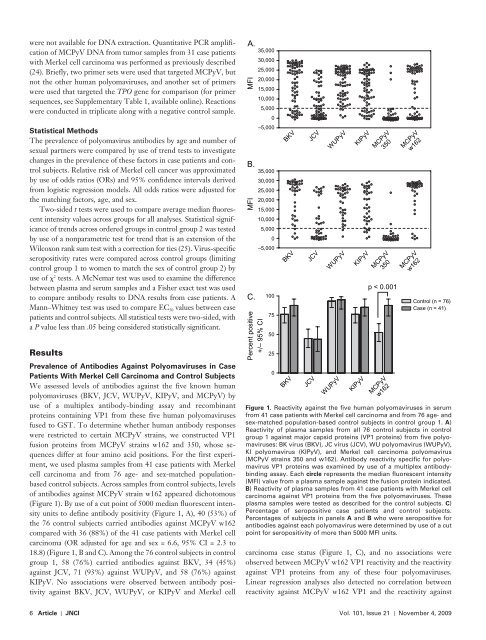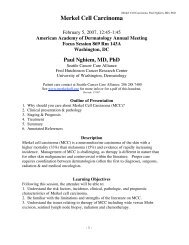Association of Merkel Cell Polyomavirus â Specific Antibodies With ...
Association of Merkel Cell Polyomavirus â Specific Antibodies With ...
Association of Merkel Cell Polyomavirus â Specific Antibodies With ...
Create successful ePaper yourself
Turn your PDF publications into a flip-book with our unique Google optimized e-Paper software.
Percent positive<br />
+/– 95% CI<br />
MFI<br />
MFI<br />
were not available for DNA extraction. Quantitative PCR amplification<br />
<strong>of</strong> MCPyV DNA from tumor samples from 31 case patients<br />
with <strong>Merkel</strong> cell carcinoma was performed as previously described<br />
( 24 ). Briefly, two primer sets were used that targeted MCPyV, but<br />
not the other human polyomaviruses, and another set <strong>of</strong> primers<br />
were used that targeted the TPO gene for comparison (for primer<br />
sequences, see Supplementary Table 1 , available online). Reactions<br />
were conducted in triplicate along with a negative control sample.<br />
A.<br />
Statistical Methods<br />
The prevalence <strong>of</strong> polyomavirus antibodies by age and number <strong>of</strong><br />
sexual partners were compared by use <strong>of</strong> trend tests to investigate<br />
changes in the prevalence <strong>of</strong> these factors in case patients and control<br />
subjects. Relative risk <strong>of</strong> <strong>Merkel</strong> cell cancer was approximated<br />
by use <strong>of</strong> odds ratios (ORs) and 95% confidence intervals derived<br />
from logistic regression models. All odds ratios were adjusted for<br />
the matching factors, age, and sex.<br />
Two-sided t tests were used to compare average median fluorescent<br />
intensity values across groups for all analyses. Statistical significance<br />
<strong>of</strong> trends across ordered groups in control group 2 was tested<br />
by use <strong>of</strong> a nonparametric test for trend that is an extension <strong>of</strong> the<br />
Wilcoxon rank sum test with a correction for ties ( 25 ). Virus-specific<br />
seropositivity rates were compared across control groups (limiting<br />
control group 1 to women to match the sex <strong>of</strong> control group 2) by<br />
use <strong>of</strong> 2 tests. A McNemar test was used to examine the difference<br />
between plasma and serum samples and a Fisher exact test was used<br />
to compare antibody results to DNA results from case patients. A<br />
Mann – Whitney test was used to compare EC 50 values between case<br />
patients and control subjects. All statistical tests were two-sided, with<br />
a P value less than .05 being considered statistically significant.<br />
B.<br />
C.<br />
35,000<br />
30,000<br />
25,000<br />
20,000<br />
15,000<br />
10,000<br />
5,000<br />
0<br />
–5,000<br />
35,000<br />
30,000<br />
25,000<br />
20,000<br />
15,000<br />
10,000<br />
5,000<br />
0<br />
–5,000<br />
100<br />
75<br />
50<br />
BKV<br />
BKV<br />
JCV<br />
JCV<br />
WUPyV<br />
WUPyV<br />
KIPyV<br />
KIPyV<br />
MCPyV<br />
350<br />
MCPyV<br />
350<br />
p < 0.001<br />
MCPyV<br />
w162<br />
MCPyV<br />
w162<br />
Control (n = 76)<br />
Case (n = 41)<br />
Results<br />
Prevalence <strong>of</strong> <strong>Antibodies</strong> Against <strong>Polyomavirus</strong>es in Case<br />
Patients <strong>With</strong> <strong>Merkel</strong> <strong>Cell</strong> Carcinoma and Control Subjects<br />
We assessed levels <strong>of</strong> antibodies against the five known human<br />
polyomaviruses (BKV, JCV, WUPyV, KIPyV, and MCPyV) by<br />
use <strong>of</strong> a multiplex antibody-binding assay and recombinant<br />
proteins containing VP1 from these five human polyomaviruses<br />
fused to GST. To determine whether human antibody responses<br />
were restricted to certain MCPyV strains, we constructed VP1<br />
fusion proteins from MCPyV strains w162 and 350, whose sequences<br />
differ at four amino acid positions. For the first experiment,<br />
we used plasma samples from 41 case patients with <strong>Merkel</strong><br />
cell carcinoma and from 76 age- and sex-matched populationbased<br />
control subjects. Across samples from control subjects, levels<br />
<strong>of</strong> antibodies against MCPyV strain w162 appeared dichotomous<br />
( Figure 1 ). By use <strong>of</strong> a cut point <strong>of</strong> 5000 median fluorescent intensity<br />
units to define antibody positivity ( Figure 1, A ), 40 (53%) <strong>of</strong><br />
the 76 control subjects carried antibodies against MCPyV w162<br />
compared with 36 (88%) <strong>of</strong> the 41 case patients with <strong>Merkel</strong> cell<br />
carcinoma (OR adjusted for age and sex = 6.6, 95% CI = 2.3 to<br />
18.8) ( Figure 1, B and C ). Among the 76 control subjects in control<br />
group 1, 58 (76%) carried antibodies against BKV, 34 (45%)<br />
against JCV, 71 (93%) against WUPyV, and 58 (76%) against<br />
KIPyV. No associations were observed between antibody positivity<br />
against BKV, JCV, WUPyV, or KIPyV and <strong>Merkel</strong> cell<br />
25<br />
0<br />
BKV<br />
JCV<br />
WUPyV<br />
KIPyV<br />
MCPyV<br />
w162<br />
Figure 1 . Reactivity against the five human polyomaviruses in serum<br />
from 41 case patients with <strong>Merkel</strong> cell carcinoma and from 76 age- and<br />
sex-matched population-based control subjects in control group 1. A )<br />
Reactivity <strong>of</strong> plasma samples from all 76 control subjects in control<br />
group 1 against major capsid proteins (VP1 proteins) from five polyomaviruses:<br />
BK virus (BKV), JC virus (JCV), WU polyomavirus (WUPyV),<br />
KI polyomavirus (KIPyV), and <strong>Merkel</strong> cell carcinoma polyomavirus<br />
(MCPyV strains 350 and w162). Antibody reactivity specific for polyomavirus<br />
VP1 proteins was examined by use <strong>of</strong> a multiplex antibodybinding<br />
assay. Each circle represents the median fluorescent intensity<br />
(MFI) value from a plasma sample against the fusion protein indicated.<br />
B ) Reactivity <strong>of</strong> plasma samples from 41 case patients with <strong>Merkel</strong> cell<br />
carcinoma against VP1 proteins from the five polyomaviruses. These<br />
plasma samples were tested as described for the control subjects. C )<br />
Percentage <strong>of</strong> seropositive case patients and control subjects.<br />
Percentages <strong>of</strong> subjects in panels A and B who were seropositive for<br />
antibodies against each polyomavirus were determined by use <strong>of</strong> a cut<br />
point for seropositivity <strong>of</strong> more than 5000 MFI units.<br />
carcinoma case status ( Figure 1, C ), and no associations were<br />
observed between MCPyV w162 VP1 reactivity and the reactivity<br />
against VP1 proteins from any <strong>of</strong> these four polyomaviruses.<br />
Linear regression analyses also detected no correlation between<br />
reactivity against MCPyV w162 VP1 and the reactivity against<br />
6 Article | JNCI Vol. 101, Issue 21 | November 4, 2009



